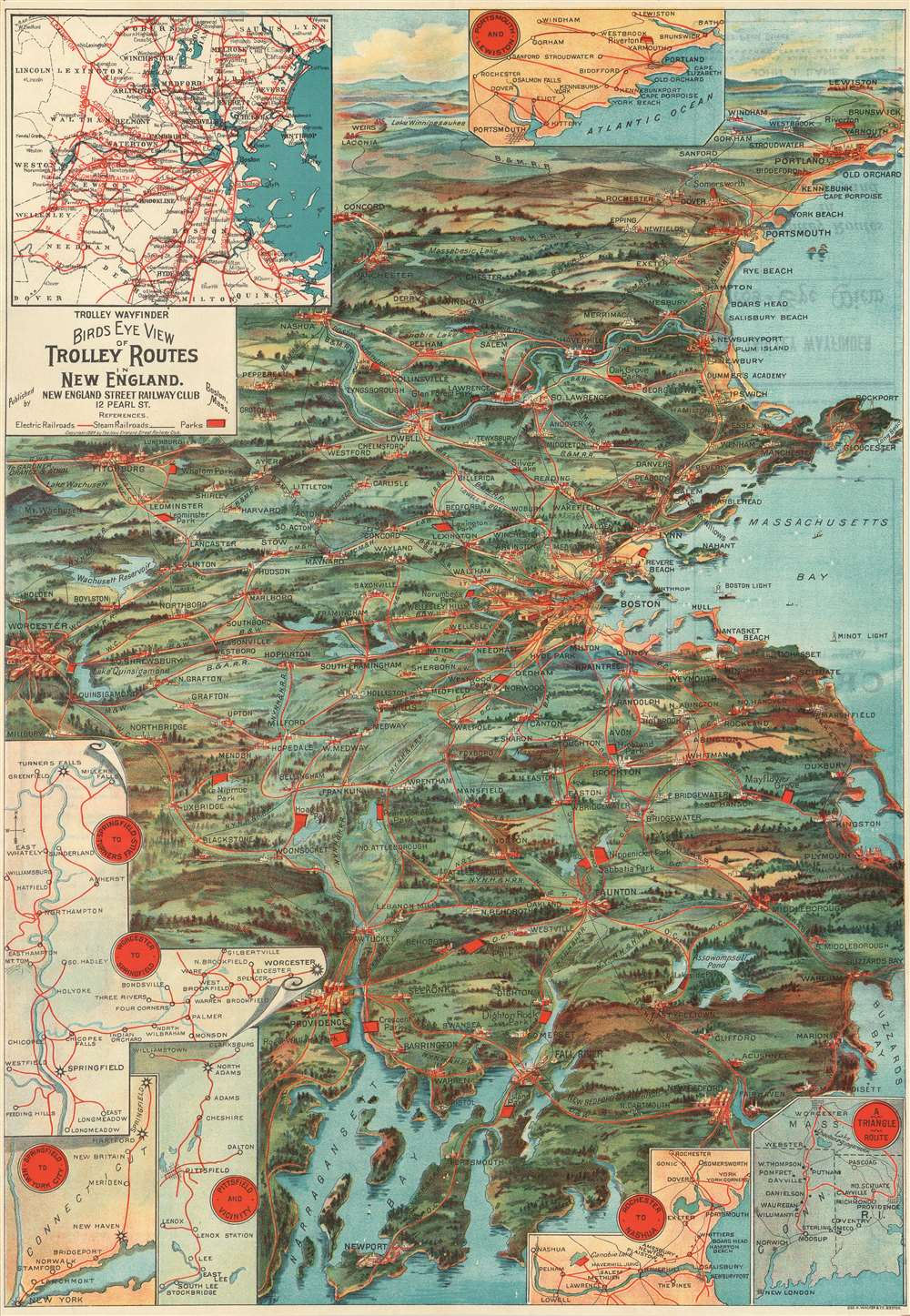
This item below is out of stock, but another example (left) is available. To view the available item, click "Details."
Details
1904 Lane Trolley Map and View of New England - 1st Edition
1904 (dated) $600.00
1904 Lane Trolley Map and View of New England - 1st Edition
TrolleyRoutesNewEngland-lane-1904
Title
1905 (dated) 20.5 x 14.25 in (52.07 x 36.195 cm)
Description
Interurban Streetcars
At the end of the 19th century, New England was serviced by an extensive network of interurban electric and steam powered streetcars. These were not proper railroads, but rather a separate system, run by various competing companies, that extended from New York to Boston, and throughout New England as far north as Bath and Lewiston, Maine. By 1919, most of the interurban streetcar lines were consolidated under the Shore Line Electric Railway. The rise of the automobile ushered in the end of streetcar travel by 1940.Chromolithography
Chromolithography is a color lithographic technique developed in the mid-19th century. The process involved using multiple lithographic stones, one for each color, to yield a rich composite effect. Oftentimes, the process would start with a black basecoat upon which subsequent colors were layered. Some chromolithographs used 30 or more separate lithographic stones to achieve the desired effect. Chromolithograph color could also be effectively blended for even more dramatic effects. The process became extremely popular in the late 19th and early 20th centuries, when it emerged as the dominate method of color printingPublication History and Census
This map was created by John Jenness Lane who contracted its production to George H. Walker of behalf of the New England Street Railway Club. The first edition, offered here, appeared in 1904 and is recognizable for exceptionally high production values with rich, vivid multi-color chromolithography. Subsequent editions, issued from 1905 to 1909, exhibit gradually less color, with some later editions issued only in black and red. The 1905 edition is the most common, but subsequent updated editions appeared annually. We have identified no other examples of the 1904 first edition despite a ghost reference (wherein no institutional holdings are identified) appearing in the OCLC. We have handled only one other example of the 1904 first edition.CartographerS
John Jenness Lane (July 5, 1860 - July 13, 1913) was a New England newspaperman, printer, editor, and publisher active in the late 19th and early 20th century. Lane was born in Candia, New Hampshire. At just 18, in 1878, Lane founded the Candia Banner, a daily servicing Candia, New Hampshire. The small newspaper was remained active until 1882. In 1880, he took over management of the Suncook, New Hampshire local. He worked for a time as an editor in Manchester New Hampshire, eventually establishing the Laconia Advocate. He also worked as a correspondent for the Boston Globe in northern New Hampshire. In 1896 he relocated to Boston to take on an editorial position at the Associated Press. Lane was an active promoter of New England Street Railroads, or Trolleys, and served as secretary of the New England Street Railway Club from 1904, when he leveraged his editorial credentials to publish an exceptional Trolley Wayfinder Map of New England. He joined the masonic order in 1904 and was active in political life, beling elected to the Board of Selectman, the Everett Common Council, and the School Board. Lane's son, Harry, died of illness in 1910, leading to a period of deep depression and physical decline that ended in his death in 1913. More by this mapmaker...
George Hiram Walker (January 4, 1852 - November 14, 1927) was a Boston based publisher of books, views, and maps active in the late 19th and early 20th centuries. Born in Springfield, Vermont, Walker started his life as a dry goods merchant but developed an active interest in publishing during the early 1870s. Walker began publishing in 1878 when he partnered with an unknown New York Firm. Two years later, Walker brought the operation in house by partnering with his brother, Oscar W. Walker, in the opening of a lithography studio at 81 Milk Street, Boston. Shortly thereafter the firm expanded to new offices at 160 Tremont Street, Boston. The Walker brothers produced a large corpus of works, most of which focused on travel and tourism in New England. Walker also established the Walker-Gordon Milk Laboratory with Dr. Thomas Morgan Rotch and Gustave Gordon. This interesting investment was based on the premise that infant deaths could be avoided by providing higher quality milk. The company eventually became a great success, producing a high-quality cow milk that closely resembled human breast milk. In the process the Walker-Gordon laboratory developed many of the dairy health standards that are still with us today. Walker married Irene L. Loud on March 25, 1885. Learn More...
New England Street Railway Club (July, 1900 - c. 1925) was a technical and engineering organization based in Boston during the late 19th and early 20th centuries. The organization was founded by Robert H. Derrah (1865 - 1920) in July of 1900. Derrah subsequently worked as the club's secretary and published its bulletin. The club was a popular and politically potent organization at a time when rail and trolley transit was common throughout New England. They held annual dinners that attracted high society from throughout the region. President Taft is recorded as speaking at one such gathering. The society issued numerous tourist oriented publications related to rail travel in New England. Learn More...

